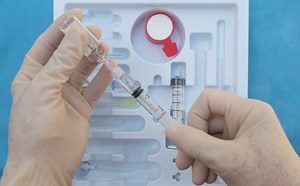
Top Five 2019 Peds Published Articles
The New Year of 2020 has commenced and with it will come new challenges, new opportunities and an abundance of new information. The sheer volume of new literature published and presented in 2019 will virtually make it impossible to keep up for most practicing PEM physicians. This is an attempt to wade through the published literature in order to identify the most impactful articles published in 2019. Compiled here are arguably the top five manuscripts that have potential impact on our day-to-day practice. Surely, there may be other articles that readers find to be more relevant and more impactful to the field, and these should be discussed on our list serve and the website. Here is the list:
Kuppermann N, Dayan P, Levine D et al. A Clinical Prediction Rule to Identify Febrile Infants 60 Days and Younger at Low Risk for Serious Bacterial Infections. JAMA Pediatr. 2019;173(4):342-351. doi:10.1001/jamapediatrics.2018.5501.
Evaluation of febrile infants under 60 days traditionally involves performance of a full sepsis screen including lumbar puncture, presumptive treatment with broad spectrum antibiotics and hospitalization. However the incidence of serious bacterial infections even in this age group has been decreasing over time and thus far there has not been a reliable way (clinically or lab test) to identify specific children that have invasive bacterial infection. Previously healthy febrile infants under 60 days old that were originally recruited for an observational multicenter study evaluating microarray analysis to detect bacterial infections were analyzed to derive and validate a prediction rule that can identify infants at low risk for SBIs. The authors were able to derive a prediction rule on a random sample of 908 infants and validated it on 913 infants. Serious bacterial infections were present in 170 of 1821 infants (9.3%), including 26 (1.4%) with bacteremia, 151 (8.3%) with urinary tract infections, and 10 (0.5%) with bacterial meningitis; 16 (0.9%) had concurrent SBIs. The prediction rule identified infants at low risk of SBI using a negative urinalysis result, an ANC of 4090/µL or less and serum procalcitonin of 1.71 ng/mL or less. In the validation cohort, the rule sensitivity was 97.7% (95% CI, 91.3-99.6), specificity was 60.0% (95% CI, 56.6-63.3), negative predictive value was 99.6% (95% CI, 98.4-99.9), and negative likelihood ratio was 0.04 (95% CI, 0.01-0.15). Interestingly, no patients with bacterial meningitis were missed by the rule. Acknowledged limitations of the study were the non-evaluation of other biomarkers, non-performance of viral testing and the relatively small sample of infants with bacteremia or meningitis. The authors recommend validation of their findings on cohorts with larger number of infections and to be cautious when managing infants under 28 days of age where the risk of invasive infection including with herpes are the greatest. One drawback with this approach is the availability and turn-around time of procalcitonin test to many EDs. However, this rule may be very useful for those febrile infants older than 30 days.
Aronson et al also attempted to derive and validate a prediction model for the identification of invasive bacterial infections in infants less than 60 days old. They found that infants that had history of fever (not febrile in the ED), normal urine analysis and an ANC count of less than 5185 have low probability of invasive bacterial infection (Pediatrics July 2019, 144 (1) e20183604; DOI: https://doi.org/10.1542/peds.2018-3604). These studies add support to clinicians that prefer to exclude lumbar puncture in well appearing febrile infants that are identified as low risk, especially for febrile infants older than 30 days.
Goetz, Virginia L.; Kim, Kelly; Stang, Antonia S. Pediatric Anaphylaxis in the Emergency Department: Clinical Presentation, Quality of Care, and Reliability of Consensus Criteria. Pediatric Emergency Care. 35(1):28-31, January 2019.
The incidence of anaphylaxis has been increasing and yet there is evidence that practitioner adherence to management guidelines for these patients is suboptimal. Goetz et al performed a retrospective chart review of patients diagnosed as anaphylaxis. Of the 250 charts reviewed, 84% (211) met the NIAID criteria for anaphylaxis, but only 68% received epinephrine in the ED or within 3 hours of the ED visit. Clinical practice guidelines for optimal management and follow-up for anaphylaxis include auto-injector epinephrine prescription, patient education, and follow-up with an allergist. They also found that adherence to documentation of discharge instructions and follow-up with a specialist was also poor. Part of the reason for such poor adherence to guidelines is the lack of universally accepted definition for anaphylaxis, even although The National Institute of Allergy and Infectious Disease and Food Allergy and Anaphylaxis criteria for anaphylaxis exists and is fairly well accepted.
Definition: Anaphylaxis is likely when any one of these three criteria is fulfilled:
Acute onset of illness (minutes to several hours) with involvement of the skin, mucosal tissue, or both (e.g., generalized hives, pruritus or flushing, swollen lips, tongue, or uvula) and at least one of the following:
- Respiratory compromise (e.g., dyspnea, wheeze or bronchospasm, stridor, reduced peak expiratory flow, hypoxemia)
- Reduced blood pressure or associated symptoms of end-organ dysfunction (e.g., hypotonia [collapse], syncope, incontinence)
Two or more of the following that occur rapidly after exposure to a likely allergen for that patient (minutes to several hours):
- Involvement of the skin or mucosal tissue (e.g., generalized hives, itch or flush, swollen lips, tongue, or uvula)
- Respiratory compromise (e.g., dyspnea, wheeze or bronchospasm, stridor, reduced peak expiratory flow, hypoxemia)
- Reduced blood pressure or associated symptoms (e.g., hypotonia [collapse], syncope, incontinence)
- Persistent gastrointestinal tract symptoms (e.g., crampy abdominal pain, vomiting)
Reduced blood pressure after exposure to known allergen for that patient (minutes to several hours):
- Infants and children: low systolic blood pressure (age specific) or >30% decrease in systolic blood pressure
- Adults: systolic blood pressure <90 mmHg or >30% decrease from that person’s baseline
Accurate diagnosis can help reduce gaps in the management of anaphylaxis and appropriate documentation and coding can aid in further identifying gaps and developing appropriate interventions to improve care. A practice parameter for ED diagnosis and management of anaphylaxis was published in 2014 and is worth reviewing for PEM practitioners. (Campbell et al. Emergency department diagnosis and treatment of anaphylaxis: a practice parameter. Ann Allergy Asthma Immunol 113 (2014) 599e608)
Merritt JL 2nd, Quinonez RA, Bonkowsky JL, Franklin WH, Gremse DA, Herman BE, Jenny C, Katz ES, Krilov LR, Norlin C, Sapién RE, Tieder JS. A Framework for Evaluation of the Higher-Risk Infant After a Brief Resolved Unexplained Event. Pediatrics. 2019;144(2) PMID 31350360
The AAP published a clinical practice guideline that defined apparent life-threatening events as brief resolved unexplained events (BRUEs) and provided evidence-based recommendations for the evaluation of infants. Lower-risk infants are defined as (1) age >60 days, (2) gestational age ≥32 weeks and postconceptional age ≥45 weeks, (3) no cardiopulmonary resuscitation required by trained medical provider, (4) BRUE duration <1 minute, and (5) first BRUE (no repeat events, regardless of time interval) as well as having no concerning historical features (eg, sudden death in a relative) and no concerning physical examination findings (eg, unexplained bruising). The clinical practice guideline did not provide recommendations for infants meeting higher-risk criteria those that did not meet low risk criteria). Merritt et al proposed a tiered approach for clinical evaluation and management of higher-risk infants with BRUE. Initial evaluation is directed towards the diagnosis of time-sensitive conditions wherein delayed diagnosis can lead to poor outcomes. These may include child abuse, cardiac dysrhythmias and severe infections. Initial evaluation may include continuous pulse oximetry monitoring, bedside feeding evaluation, electrocardiogram, CBC, Electrolytes, lactate, blood gas analysis, rapid viral respiratory panel testing, pertussis polymerase chain reaction in endemic areas, brain imaging if abuse suspected and social worker consult. If no cause is revealed, a secondary evaluation is performed to diagnose conditions are less sensitive to delayed diagnosis such as epilepsy, dysphagia, or intermittent partial airway obstruction. Work up is determined based on history and physical examination clues. The authors advise an individually tailored, family-centered, multidisciplinary approach for all children with a higher risk BRUE. Decision to hospitalize is based on shared decision making with consideration of risks and benefits. This article provides a rational and practical guidance for managing high risk BRUE. In another study, 87 infants with low risk BRUE were followed for up to 5 years. There was no mortality within the group and none developed cardiovascular disease or seizures. Three children developed autism spectrum disorder (higher than average) and 22% were rehospitalized of whom 10% were for recurrent choking due to GE reflux. (Ari, A; Atias, Y; Amir, J. Long-Term Follow-Up of Infants After a Brief Resolved Unexplained Event–Related Hospitalization. Pediatric Emergency Care. 35(11):765-768, November 2019.) This study reassures that the prognosis for infants with low risk BRUE is excellent.
Holmberg MJ, Wiberg S, Ross CE, Kleinman M, Hoeyer-Nielsen AK, Donnino MW, Andersen LW Trends in Survival After Pediatric In-Hospital Cardiac Arrest in the United States. Circulation. 2019; 140 (17):1398. Epub 2019 Sep 23
CPR is performed in approximately 15000 pediatric patients in US hospitals annually but there isn’t much information about temporal trends in survival to hospital discharge for pediatric patients. The authors used the Get With The Guidelines-Resuscitation registry (Timeline: 2000-2018) to determine these trends. They performed a separate analysis for patients with pulseless cardiac arrest and those with non-pulseless cardiac arrest (bradycardia with poor perfusion; including those with shockable and non-shockable rhythms). They found that survival for pulseless cardiac arrest was 19% in 2000 and improved to 38% in in 2018, although the survival rate stagnated after 2010. Return of spontaneous circulation also improved over this time period. There was no association between initial cardiac rhythm and survival. The survival for non-pulseless cardiac arrest improved from 57% in 2000 to 66% in 2018. Early recognition of potential events, improved CPR techniques, revised guidelines of resuscitation and improvements in post resuscitation care may have contributed to this improvement. PEM practitioners and intensivists should be encouraged by these trends although overall mortality remains high.
Delayed Presentations to Emergency Departments of Children With Head Injury: A PREDICT Study. Borland ML, Dalziel SR, Phillips N, Lyttle MD, Bressan S, Oakley E, Hearps SJC, Kochar A, Furyk J, Cheek JA, Neutze J, Gilhotra Y, Dalton S, Babl FE; Paediatric Research in Emergency Department International Collaborative (PREDICT) Group. Ann Emerg Med. 2019 Jul;74(1):1-10. doi: 10.1016/j.annemergmed.2018.11.035. Epub 2019 Jan 14.
The Paediatric Research in Emergency Department International Collaborative (PREDICT) Group looked at an important group of head trauma children, those that present to the ED after 24 hours of injury. There are excellent decision rules for acute head trauma management but nothing of note that guides practitioners for the group that presents late. Borland ML et al performed secondary analysis of the Australasian Paediatric Head Injury Rule Study focused on children presenting more than 24 hours after head injury, with Glasgow Coma Scale scores 14 and 15. Of the 981 infants evaluated, traumatic brain injury on CT occurred in 37 patients (3.8%), including suspicion of depressed skull fracture (8 [0.8%]) and intracranial hemorrhage (31 [3.8%]). Overall, clinically important traumatic brain injury occurred in 8 patients (0.8%), with 2 (0.2%) requiring neurosurgery, with no deaths. They concluded that delayed presentation after head injury, although infrequent, is significantly associated with traumatic brain injury. Practitioners should be more cautious when evaluating children presenting with delayed head injury and perhaps have a lower threshold to obtain imaging to detect traumatic brain injuries.
Noah Kondamudi, MD, MBA, FAAP, FACEP, CPE




